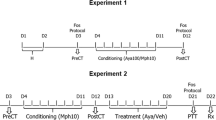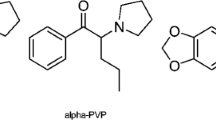Abstract
Introduction
Prior research indicates methylphenidate (MPH) and alcohol (ethanol, EtOH) interact to significantly affect responses humans and mice. The present studies tested the hypothesis that MPH and EtOH interact to potentiate ethanol-related behaviors in mice.
Methods
We used several behavioral tasks including: drug discrimination in MPH-trained and EtOH-trained mice, conditioned place preference (CPP), rota-rod and the parallel rod apparatus. We also used gas chromatographic methods to measure brain tissue levels of EtOH and the d- and l-isomers of MPH and the metabolite, ethylphenidate (EPH).
Results
In discrimination, EtOH (1 g/kg) produced a significant leftward shift in the MPH generalization curve (1–2 mg/kg) for MPH-trained mice, but no effects of MPH (0.625–1.25 mg/kg) on EtOH discrimination in EtOH-trained mice (0–2.5 g/kg) were observed. In CPP, the MPH (1.25 mg/kg) and EtOH (1.75 g/kg) combination significantly increased time on the drug paired side compared to vehicle (30.7 %), but this was similar to MPH (28.8 %) and EtOH (33.6 %). Footslip errors measured in a parallel rod apparatus indicated that the drug combination was very ataxic, with footslips increasing 29.5 % compared to EtOH. Finally, brain EtOH concentrations were not altered by 1.75 g/kg EtOH combined with 1.25 mg/kg MPH. However, EtOH significantly increased d-MPH and l-EPH without changing l-MPH brain concentrations.
Conclusions
The enhanced behavioral effects when EtOH is combined with MPH are likely due to the selective increase in brain d-MPH concentrations. These studies are consistent with observations in humans of increased interoceptive awareness of the drug combination and provide new clinical perspectives regarding enhanced ataxic effects of this drug combination.





Similar content being viewed by others
References
Barrett SP, Pihl RO (2002) Oral methylphenidate–alcohol co-abuse. J Clin Psychopharmacol 22(6):633–634
Barrett SP, Darredeau C, Pihl RO (2006) Patterns of simultaneous polysubstance use in drug using university students. Hum Psychopharmacol 21(4):255–263
Becker HC, Baros AM (2006) Effect of duration and pattern of chronic ethanol exposure on tolerance to the discriminative stimulus effects of ethanol in C57BL/6J mice. J Pharmacol Exp Ther 319(2):871–878
Bell GH, Griffin WC 3rd, Patrick KS (2011a) Oral and transdermal dl-methylphenidate–ethanol interactions in C57BL/6J mice: potentiation of locomotor activity with oral delivery. Pharmacol Biochem Behav 100(2):264–270
Bell GH, Novak AJ, Griffin WC 3rd, Patrick KS (2011b) Transdermal and oral dl-methylphenidate–ethanol interactions in C57BL/6J mice: transesterification to ethylphenidate and elevation of d-methylphenidate concentrations. J Pharm Sci 100(7):2966–2978
Berridge CW, Devilbiss DM, Andrzejewski ME, Arnsten AF, Kelley AE, Schmeichel B et al (2006) Methylphenidate preferentially increases catecholamine neurotransmission within the prefrontal cortex at low doses that enhance cognitive function. Biol Psychiatry 60(10):1111–1120
Biederman J, Faraone SV (2005) Attention-deficit hyperactivity disorder. Lancet 366(9481):237–248
Biederman J, Spencer T (2002) Methylphenidate in treatment of adults with Attention-Deficit/Hyperactivity Disorder. J Atten Disord 6(Suppl 1):S101–S107
Crissman AM, Studders SL, Becker HC (2004) Tolerance to the discriminative stimulus effects of ethanol following chronic inhalation exposure to ethanol in C57BL/6J mice. Behav Pharmacol 15(8):569–575
Cunningham CL, Patel P (2007) Rapid induction of Pavlovian approach to an ethanol-paired visual cue in mice. Psychopharmacol 192(2):231–241
Cunningham CL, Patel P, Milner L (2006) Spatial location is critical for conditioning place preference with visual but not tactile stimuli. Behav Neurosci 120(5):1115–1132
Darredeau C, Barrett SP, Jardin B, Pihl RO (2007) Patterns and predictors of medication compliance, diversion, and misuse in adult prescribed methylphenidate users. Hum Psychopharmacol 22(8):529–536
dela Peńa IC, Ahn HS, Choi JY, Shin CY, Ryu JH, Cheong JH (2011) Methylphenidate self-administration and conditioned place preference in an animal model of attention-deficit hyperactivity disorder: the spontaneously hypertensive rat. Behav Pharmacol 22(1):31–39
dela Peña I, Lee JC, Lee HL, Woo TS, Lee HC, Sohn AR et al (2012) Differential behavioral responses of the spontaneously hypertensive rat to methylphenidate and methamphetamine: lack of a rewarding effect of repeated methylphenidate treatment. Neurosci Lett 514(2):189–193
Godfrey J (2009) Safety of therapeutic methylphenidate in adults: a systematic review of the evidence. J Psychopharmacol 23(2):194–205
Griffin WC 3rd, Novak AJ, Middaugh LD, Patrick KS (2010) The interactive effects of methylphenidate and ethanol on ethanol consumption and locomotor activity in mice. Pharmacol Biochem Behav 95(3):267–272
Hasin DS, Stinson FS, Ogburn E, Grant BF (2007) Prevalence, correlates, disability, and comorbidity of DSM-IV alcohol abuse and dependence in the United States: results from the National Epidemiologic Survey on Alcohol and Related Conditions. Arch Gen Psychiatry 64(7):830–842
Jerlhag E (2008) The antipsychotic aripiprazole antagonizes the ethanol- and amphetamine-induced locomotor stimulation in mice. Alcohol 42(2):123–127
Johnston LD, O'Malley PM, Bachman JG, Schulenberg JE (2008). Monitoring the future national results on adolescent drug use: overview of key findings, 2007. edn, vol. NIH Publication No. 08-6418. National Institute on Drug Abuse, Bethesda, MD
Kamens HM, Crabbe JC (2007) The parallel rod floor test: a measure of ataxia in mice. Nat Protoc 2(2):277–281
Kamens HM, Phillips TJ, Holstein SE, Crabbe JC (2005) Characterization of the parallel rod floor apparatus to test motor incoordination in mice. Genes Brain Behav 4(4):253–266
Kroutil LA, Van Brunt DL, Herman-Stahl MA, Heller DC, Bray RM, Penne MA (2006) Nonmedical use of prescription stimulants in the United States. Drug Alcohol Depend 84(2):135–143
Kuczenski R, Segal DS (1997) Effects of methylphenidate on extracellular dopamine, serotonin, and norepinephrine: comparison with amphetamine. J Neurochem 68(5):2032–2037
Kuczenski R, Segal DS (2001) Locomotor effects of acute and repeated threshold doses of amphetamine and methylphenidate: relative roles of dopamine and norepinephrine. J Pharmacol Exp Ther 296(3):876–883
Kuczenski R, Segal DS (2005) Stimulant actions in rodents: implications for attention-deficit/hyperactivity disorder treatment and potential substance abuse. Biol Psychiatry 57(11):1391–1396
LeVasseur NL, Zhu HJ, Markowitz JS, DeVane CL, Patrick KS (2008) Enantiospecific gas chromatographic-mass spectrometric analysis of urinary methylphenidate: implications for phenotyping. J Chromatogr B Anal Technol Biomed Life Sci 862(1–2):140–149
Mallonee E, Calvin S (2005). Emergency Department Visits Involving Underage Drinking 2004. The New DAWN Report 1-4
Manjanatha MG, Shelton SD, Dobrovolsky VN, Shaddock JG, McGarrity LG, Doerge DR et al (2008) Pharmacokinetics, dose-range, and mutagenicity studies of methylphenidate hydrochloride in B6C3F1 mice. Environ Mol Mutagen 49(8):585–593
Markowitz JS, Patrick KS (2008) Differential pharmacokinetics and pharmacodynamics of methylphenidate enantiomers: does chirality matter? J Clin Psychopharmacol 28(3 Suppl 2):S54–S61
Markowitz JS, Logan BK, Diamond F, Patrick KS (1999) Detection of the novel metabolite ethylphenidate after methylphenidate overdose with alcohol coingestion. J Clin Psychopharmacol 19(4):362–366
Markowitz JS, DeVane CL, Boulton DW, Nahas Z, Risch SC, Diamond F et al (2000) Ethylphenidate formation in human subjects after the administration of a single dose of methylphenidate and ethanol. Drug Metab Dispos 28(6):620–624
Martin CS (2008) Timing of alcohol and other drug use. Alcohol Res Health 31(2):96–99
McCabe SE, Teter CJ, Boyd CJ, Guthrie SK (2004) Prevalence and correlates of illicit methylphenidate use among 8th, 10th, and 12th grade students in the United States, 2001. J Adol Health 35(6):501–504
McCabe SE, Cranford JA, Morales M, Young A (2006) Simultaneous and concurrent polydrug use of alcohol and prescription drugs: prevalence, correlates, and consequences. J Stud Alcohol 67(4):529–537
McGovern RW, Middaugh LD, Patrick KS, Griffin WC 3rd (2011) The discriminative stimulus properties of methylphenidate in C57BL/6J mice. Behav Pharmacol 22(1):14–22
Middaugh LD, Boggan WO, Randall CL (1987) Stimulatory effects of ethanol in C57BL/6 mice. Pharmacol Biochem Behav 27(3):421–424
Middaugh LD, Bao K, Shepherd CL (1992) Comparative effects of ethanol on motor activity and operant behavior. Pharmacol Biochem Behav 43(2):625–629
Nocjar C, Middaugh LD, Tavernetti M (1999) Ethanol consumption and place-preference conditioning in the alcohol-preferring C57BL/6 mouse: relationship with motor activity patterns. Alcohol Clin Exp Res 23(4):683–692
Okie S (2006) ADHD in adults. N Engl J Med 354(25):2637–2641
Patrick KS, Kilts CD, Breese GR (1981) Synthesis and pharmacology of hydroxylated metabolites of methylphenidate. J Med Chem 24(10):1237–1240
Patrick KS, Caldwell RW, Ferris RM, Breese GR (1987) Pharmacology of the enantiomers of threo-methylphenidate. J Pharmacol Exp Ther 241(1):152–158
Patrick KS, Williard RL, VanWert AL, Dowd JJ, Oatis JE Jr, Middaugh LD (2005) Synthesis and pharmacology of ethylphenidate enantiomers: the human transesterification metabolite of methylphenidate and ethanol. J Med Chem 48(8):2876–2881
Patrick KS, Straughn AB, Minhinnett RR, Yeatts SD, Herrin AE, DeVane CL et al (2007) Influence of ethanol and gender on methylphenidate pharmacokinetics and pharmacodynamics. Clin Pharmacol Ther 81(3):346–353
Schechter MD (1988) Advantages and disadvantages of a rapid method to train drug discrimination. Pharmacol Biochem Behav 31(1):239–242
Stolerman IP, Childs E, Ford MM, Grant KA (2011) Role of training dose in drug discrimination: a review. Behav Pharmacol 22(5–6):415–429
Szumlinski KK, Price KL, Frys KA, Middaugh LD (2002) Unconditioned and conditioned factors contribute to the 'reinstatement' of cocaine place conditioning following extinction in C57BL/6 mice. Behav Brain Res 136(1):151–160
Teter CJ, McCabe SE, LaGrange K, Cranford JA, Boyd CJ (2006) Illicit use of specific prescription stimulants among college students: prevalence, motives, and routes of administration. Pharmacotherapy 26(10):1501–1510
Trezza V, Damsteegt R, Vanderschuren LJMJ (2009) Conditioned place preference induced by social play behavior: parametrics, extinction, reinstatement and disruption by methylphenidate. Eur Neuropsychopharmacol 19(9):659–669
Williard RL, Middaugh LD, Zhu HJ, Patrick KS (2007) Methylphenidate and its ethanol transesterification metabolite ethylphenidate: brain disposition, monoamine transporters and motor activity. Behav Pharmacol 18(1):39–51
Wooters TE, Walton MT, Bardo MT (2011) Oral methylphenidate establishes a conditioned place preference in rats. Neurosci Lett 487(3):293–296
Zhu HJ, Patrick KS, Yuan HJ, Wang JS, Donovan JL, DeVane CL et al (2008) Two CES1 gene mutations lead to dysfunctional carboxylesterase 1 activity in man: clinical significance and molecular basis. Am J Hum Genet 82(6):1241–1248
Zhu HJ, Patrick KS, Markowitz JS (2011a) Enantiospecific determination of dl-methylphenidate and dl-ethylphenidate in plasma by liquid chromatography-tandem mass spectrometry: application to human ethanol interactions. J Chromatogr B Anal Technol Biomed Life Sci 879(11–12):783–788
Zhu J, Spencer TJ, Liu-Chen L-Y, Biederman J, Bhide PG (2011b) Methylphenidate and μ opioid receptor interactions: a pharmacological target for prevention of stimulant abuse. Neuropharmacology 61(1–2):283–292
Acknowledgments
The authors thank J. Reid Spears, Kathyrn Balcewicz, and Andrew Novak for expert technical assistance. Funding was provided by NIGMS Postdoctoral Scholarship K12 GM081265 to RWM and NIAAA RO1 AA016707 to KSP.
Conflict of interest
The authors have no conflicts of interest to disclose.
Author information
Authors and Affiliations
Corresponding author
Rights and permissions
About this article
Cite this article
Griffin, W.C., McGovern, R.W., Bell, G.H. et al. Interactive effects of methylphenidate and alcohol on discrimination, conditioned place preference and motor coordination in C57BL/6J mice. Psychopharmacology 225, 613–625 (2013). https://doi.org/10.1007/s00213-012-2849-z
Received:
Accepted:
Published:
Issue Date:
DOI: https://doi.org/10.1007/s00213-012-2849-z




